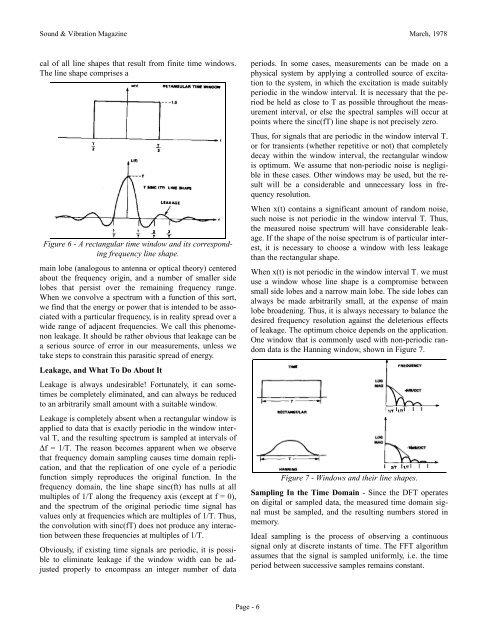Fundamentals of the Discrete Fourier Transform
Fundamentals of the Discrete Fourier Transform
Fundamentals of the Discrete Fourier Transform
Create successful ePaper yourself
Turn your PDF publications into a flip-book with our unique Google optimized e-Paper software.
Sound & Vibration Magazine March, 1978<br />
cal <strong>of</strong> all line shapes that result from finite time windows.<br />
The line shape comprises a<br />
Figure 6 - A rectangular time window and its corresponding<br />
frequency line shape.<br />
main lobe (analogous to antenna or optical <strong>the</strong>ory) centered<br />
about <strong>the</strong> frequency origin, and a number <strong>of</strong> smaller side<br />
lobes that persist over <strong>the</strong> remaining frequency range.<br />
When we convolve a spectrum with a function <strong>of</strong> this sort,<br />
we find that <strong>the</strong> energy or power that is intended to be associated<br />
with a particular frequency, is in reality spread over a<br />
wide range <strong>of</strong> adjacent frequencies. We call this phenomenon<br />
leakage. It should be ra<strong>the</strong>r obvious that leakage can be<br />
a serious source <strong>of</strong> error in our measurements, unless we<br />
take steps to constrain this parasitic spread <strong>of</strong> energy.<br />
Leakage, and What To Do About It<br />
Leakage is always undesirable! Fortunately, it can sometimes<br />
be completely eliminated, and can always be reduced<br />
to an arbitrarily small amount with a suitable window.<br />
Leakage is completely absent when a rectangular window is<br />
applied to data that is exactly periodic in <strong>the</strong> window interval<br />
T, and <strong>the</strong> resulting spectrum is sampled at intervals <strong>of</strong><br />
Δf = 1/T. The reason becomes apparent when we observe<br />
that frequency domain sampling causes time domain replication,<br />
and that <strong>the</strong> replication <strong>of</strong> one cycle <strong>of</strong> a periodic<br />
function simply reproduces <strong>the</strong> original function. In <strong>the</strong><br />
frequency domain, <strong>the</strong> line shape sinc(ft) has nulls at all<br />
multiples <strong>of</strong> 1/T along <strong>the</strong> frequency axis (except at f = 0),<br />
and <strong>the</strong> spectrum <strong>of</strong> <strong>the</strong> original periodic time signal has<br />
values only at frequencies which are multiples <strong>of</strong> 1/T. Thus,<br />
<strong>the</strong> convolution with sinc(fT) does not produce any interaction<br />
between <strong>the</strong>se frequencies at multiples <strong>of</strong> 1/T.<br />
Obviously, if existing time signals are periodic, it is possible<br />
to eliminate leakage if <strong>the</strong> window width can be adjusted<br />
properly to encompass an integer number <strong>of</strong> data<br />
Page - 6<br />
periods. In some cases, measurements can be made on a<br />
physical system by applying a controlled source <strong>of</strong> excitation<br />
to <strong>the</strong> system, in which <strong>the</strong> excitation is made suitably<br />
periodic in <strong>the</strong> window interval. It is necessary that <strong>the</strong> period<br />
be held as close to T as possible throughout <strong>the</strong> measurement<br />
interval, or else <strong>the</strong> spectral samples will occur at<br />
points where <strong>the</strong> sinc(fT) line shape is not precisely zero.<br />
Thus, for signals that are periodic in <strong>the</strong> window interval T.<br />
or for transients (whe<strong>the</strong>r repetitive or not) that completely<br />
decay within <strong>the</strong> window interval, <strong>the</strong> rectangular window<br />
is optimum. We assume that non-periodic noise is negligible<br />
in <strong>the</strong>se cases. O<strong>the</strong>r windows may be used, but <strong>the</strong> result<br />
will be a considerable and unnecessary loss in frequency<br />
resolution.<br />
When x(t) contains a significant amount <strong>of</strong> random noise,<br />
such noise is not periodic in <strong>the</strong> window interval T. Thus,<br />
<strong>the</strong> measured noise spectrum will have considerable leakage.<br />
If <strong>the</strong> shape <strong>of</strong> <strong>the</strong> noise spectrum is <strong>of</strong> particular interest,<br />
it is necessary to choose a window with less leakage<br />
than <strong>the</strong> rectangular shape.<br />
When x(t) is not periodic in <strong>the</strong> window interval T. we must<br />
use a window whose line shape is a compromise between<br />
small side lobes and a narrow main lobe. The side lobes can<br />
always be made arbitrarily small, at <strong>the</strong> expense <strong>of</strong> main<br />
lobe broadening. Thus, it is always necessary to balance <strong>the</strong><br />
desired frequency resolution against <strong>the</strong> deleterious effects<br />
<strong>of</strong> leakage. The optimum choice depends on <strong>the</strong> application.<br />
One window that is commonly used with non-periodic random<br />
data is <strong>the</strong> Hanning window, shown in Figure 7.<br />
Figure 7 - Windows and <strong>the</strong>ir line shapes.<br />
Sampling In <strong>the</strong> Time Domain - Since <strong>the</strong> DFT operates<br />
on digital or sampled data, <strong>the</strong> measured time domain signal<br />
must be sampled, and <strong>the</strong> resulting numbers stored in<br />
memory.<br />
Ideal sampling is <strong>the</strong> process <strong>of</strong> observing a continuous<br />
signal only at discrete instants <strong>of</strong> time. The FFT algorithm<br />
assumes that <strong>the</strong> signal is sampled uniformly, i.e. <strong>the</strong> time<br />
period between successive samples remains constant.


